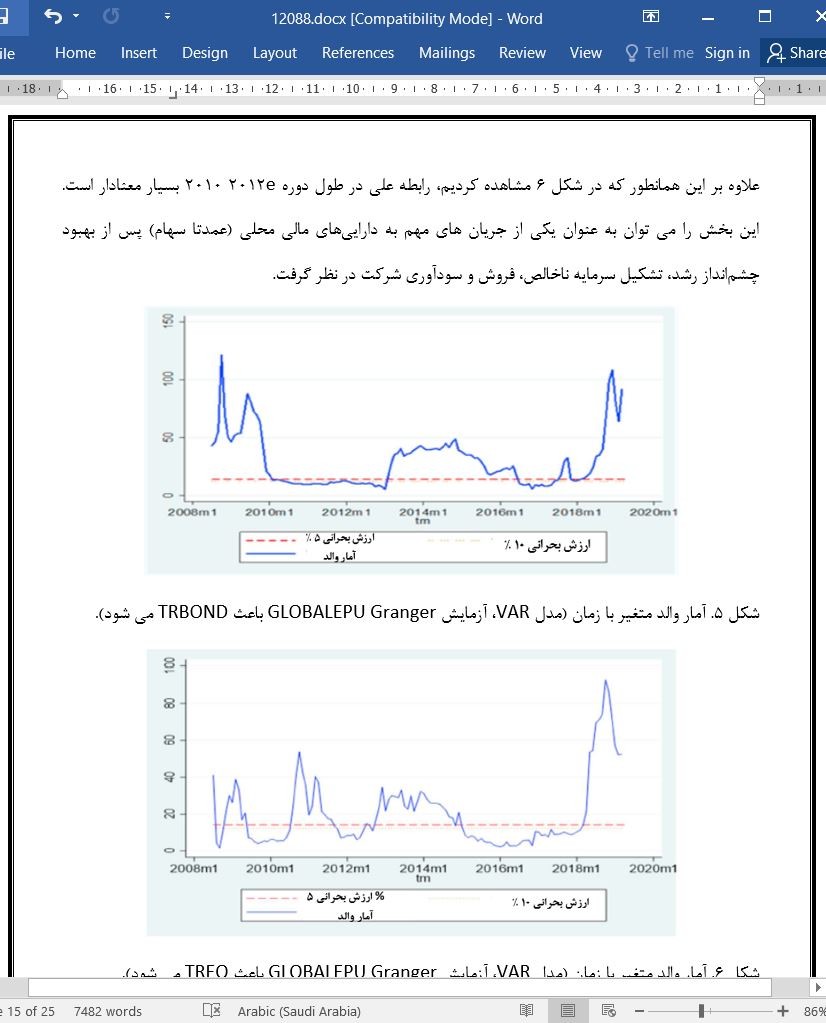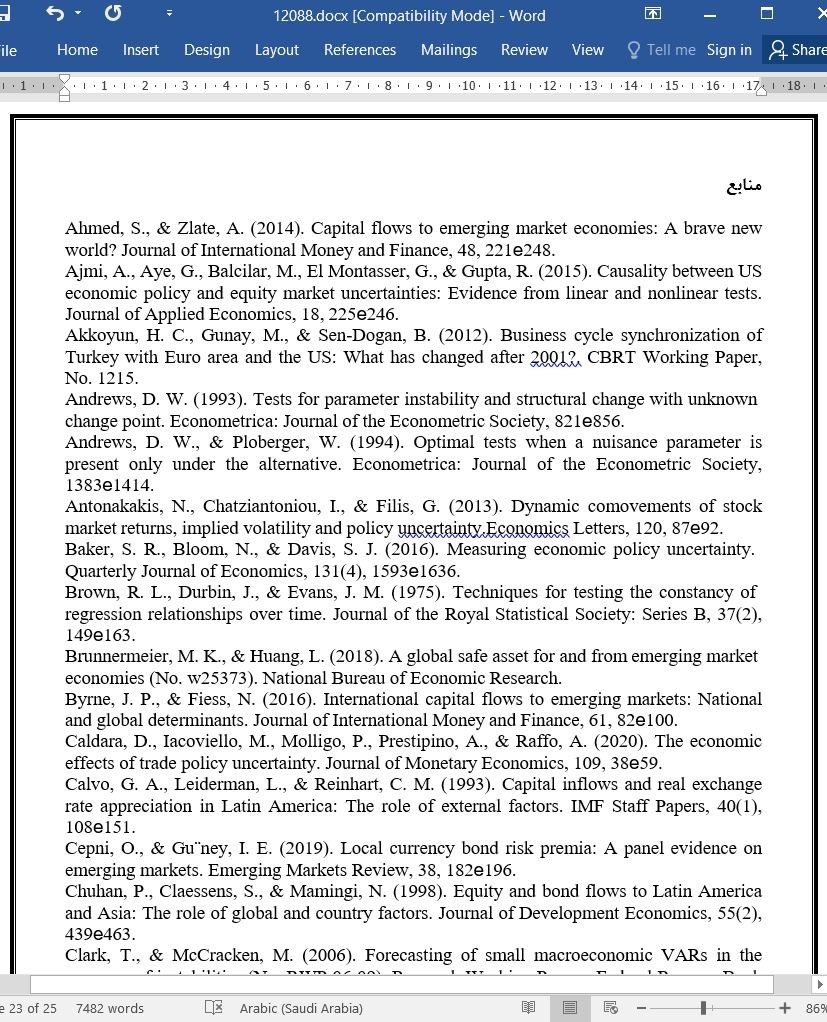
جریان سرمایه تحت عدم قطعیت جهانی: شواهدی از ترکیه
چکیده مطلب
مقاله حاضر اثرات عدم قطعیت اقتصادی جهانی و عدم قطعیت ناشی از سیاست تجاری در ایالات متحده را برای پیش بینی جریان اوراق قرضه و سهام به ترکیه در طول دوره ژانویه ۲۰۰۸ تا نوامبر ۲۰۱۹ بررسی می کند. ما از آزمون علیت گرنجر متغیر با زمان برای ارزیابی توانایی عدم قطعیت سیاست اقتصادی و جریان سرمایه برای پیش بینی بازارهای سهام و اوراق قرضه ترکیه استفاده می کنیم. و از داده های سطح سرمایه در جریان سهام و اوراق قرضه که توسط پایگاه داده جهانی تحقیقات صندوق سرمایه گذاری نوپا (EPFR) گردآوری شده است بهره می بریم. هرچند ما هیچ نشانه ای از علیت در آزمون علیت گرنجر استاندارد را نیافتیم، اما آزمون علیت استواری با متغیر زمان، دوره های مهمی را مشخص می کند که رابطه علی بین جریان های سرمایه و شاخص های عدم قطعیت را نشان می دهد؛ به ویژه در دوران بحران مالی جهانی و انتخاب دولت ترامپ.
1. مقدمه و پیشینه مطالعات
موج قابل توجهی در جریان های سرمایه به بازارهای نوپا (EMs) در دهه های اخیر به وجود آمده است. تمایل جهانی فزاینده برای ریسک در محیطی با نرخ بهره پایین و نقدینگی فراوان در کشورهای توسعه یافته همراه با بهبود چشم انداز رشد در EM های فردی، جریان های نقدی را به ابزارهای مالی داخلی گسترش داده است. این روندها به EM ها کمک کرد تا خلا پس انداز خود را پر کنند، سرمایه کسری حساب جاری را تامین کنند، و به وجوه جهانی نسبتا ارزان تر دسترسی داشته باشند. علاوه بر این، به دلیل افزایش نرخ واقعی ارز در زمان ورود سرمایه قوی، EM ها اخیرا از تورم کم و با نوسان کمتری برخوردار بوده اند که قبل از دهه ۲۰۰۰ در پیشینه آنها دیده نشده بود. با توجه به این شرایط نقدینگی مطلوب، در دوره پس از بحران مالی جهانی (GFC)، اقتصاد ترکیه به دلیل سرریزهای منطقه ای یا جهانی که در چندین موقعیت قبلی مشاهده شده بود، بحران مالی عمده ای را تجربه نکرد (کومرت و سلمان 2018). با این وجود، GFC که به طور عمده در کشورهای توسعه یافته آغاز شد، پیامدهایی برای EM ها به همراه داشت زیرا به دلیل نرخ پس انداز پایین، به شدت به سرمایه خارجی وابسته است. به غیر از GFC ، در برخی موارد کاهش جریان سرمایه به نشانه هایی از بی ثباتی مالی مانند نوسانات نرخ ارز و تورم و همچنین ورشکستگی منتهی شده است. به عنوان مثال می توان به بحران بدهی اروپا در نیمه دوم سال 2011 اشاره کرد. اتفاقات بعد از می 2013 و عادی سازی سیاست پولی توسط بانک مرکزی ایالات متحده بانک مرکزی ایالات متحده آمریکا (فدرال رزرو) از سال 2015 تا اواخر سال 2016 (شکل 1) انجام شد. به طور کلی، اگر چه جریان سرمایه به یک محیط رشد مثبت و نرخ ارز کم تر در EM کمک کرده است، همچنین به بدهی بالا در EM ها منهتی شد (شکل ۲) و به دلیل احتمال کاهش ناگهانی جریان سرمایه، منجر به بی ثباتی چشم گیری در بازارهای مالی آنها شد.
Abstract
This paper investigates the effects of global economic uncertainty and trade policy–related uncertainty in the US in predicting the bond and equity flows to Turkey during the period from January 2008 to November 2019. We use the time-varying Granger-causality test to assess the ability of economic policy uncertainty and capital flows to forecast Turkish equity and bond markets using fund-level data on bond and equity inflows compiled by the Emerging Portfolio Fund Research (EPFR) global database. Although we found no evidence of causality in the standard Granger-causality test, the time-varying robust causality test detects significant episodes that imply a causal relationship between capital flows and uncertainty indexes, especially during the global financial crisis and the election of the Trump administration.
1. Introduction and literature review
A substantial surge in capital flows to emerging markets (EMs) has occurred in recent decades. The rising global appetite for risk in an environment of low interest rates and abundant liquidity in developed countries, coupled with improving growth prospects in individual EMs, has expanded the cash flows to domestic financial instruments. These trends helped EMs fill their savings gaps, finance their current account deficits, and access relatively cheaper global funds. Furthermore, because of the rise in real exchange rates in times of robust capital inflows, EMs recently enjoyed low and less-volatile inflation, which had not been seen in their history before the 2000s. Because of these favorable liquidity conditions, in the posteglobal financial crisis (GFC) period, the Turkish economy did not experience a major financial crisis due to either regional or global spillover, which had been observed on several earlier occasions (Comert & Selman 2018). Nevertheless, the GFC, mainly initiated in developed countries, had implications for the EMs because they are highly dependent on external capital due to a low savings rate. Apart from the GFC, in some cases, the reductions in the capital inflows have led to signs of financial instability, including volatility in exchange rates and inflation as well as bankruptcies. Examples include the European sovereign debt crisis in the second half of 2011, the so-called taper tantrum after May 2013, and normalization of monetary policy by the US Federal Reserve (the Fed) from 2015 until late 2016 (Fig. 1). Overall, although capital flows contributed to a positive growth environment and less-volatile inflation and exchange rates in EMs, they also resulted in high debt in EMs (Fig. 2) and led to significant instability in their financial markets because of the potential for sudden reductions in capital flows.
چکیده مطلب
1. مقدمه و پیشینه مطالعات
2. داده
3. روش شناسی
4. نتایج تجربی
5. نتیجه گیری
منابع
Abstract
1. Introduction and literature review
2. Data
3. Methodology
4. Empirical findings
5. Conclusion
Conflict of interest
References
- اصل مقاله انگلیسی با فرمت ورد (word) با قابلیت ویرایش
- ترجمه فارسی مقاله با فرمت ورد (word) با قابلیت ویرایش، بدون آرم سایت ای ترجمه
- ترجمه فارسی مقاله با فرمت pdf، بدون آرم سایت ای ترجمه



